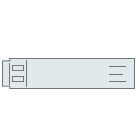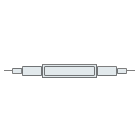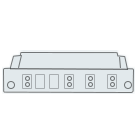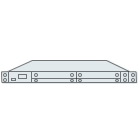Fiber Optic Tech
Fiber Bypass Modules: Keep Your Network Running—Always
1. Background and Market Demand
In modern optical communication networks, high availability and service continuity have become critical requirements. As data centers, enterprise networks, and industrial systems continue to expand, the number of in-line network security devices—such as firewalls, intrusion prevention/detection systems (IPS/IDS), and unified threat management (UTM) devices—is increasing rapidly. These devices are essential but also introduce potential single points of failure. If one of these devices crashes or reboots, it may interrupt the entire network link, leading to data loss or service downtime.
To address this challenge, Fiber Bypass Modules were developed. These devices automatically reroute traffic around a failed or offline in-line appliance, ensuring that network traffic continues to flow even when security or monitoring equipment becomes unavailable. This greatly improves network resilience and uptime.
The fiber bypass module is a pivotal component in optical fiber communication networks, designed to ensure network continuity by automatically or manually rerouting optical signals to backup paths during equipment failures, maintenance, or power outages. With the global surge in data traffic, driven by advancements in cloud computing, 5G networks, data centers, and the Internet of Things (IoT), the demand for stable and highly available optical networks has never been greater. Traditional optical networks risk service interruptions during equipment failures or scheduled maintenance, but fiber bypass modules mitigate these risks by enabling seamless path switching, reducing downtime, lowering operational costs, and enhancing service reliability.
The need for fiber bypass modules stems from several key drivers:
High Availability Requirements: Industries such as data centers and telecommunications demand uptime, and fiber bypass modules play a critical role in minimizing network disruptions.
Maintenance Efficiency: These modules allow network upgrades or maintenance without interrupting active services, streamlining operations.
Cost Savings: By reducing downtime, fiber bypass modules help organizations avoid significant revenue losses associated with network outages.
5G and IoT Expansion: The ultra-low latency and high-bandwidth requirements of 5G and IoT applications underscore the importance of fiber bypass modules in maintaining robust and reliable network performance.
2. Types of Fiber Bypass Modules
Fiber Bypass Modules can be categorized based on fiber type, supported data rates, and bypass mechanism.
2.1 By Fiber Type
Single-mode Fiber Bypass Modules
Designed for long-distance transmission;
Operate typically at 1310nm or 1550nm wavelengths;
Commonly used in backbone and inter-building connections;
Supported rates: 1.25G, 10G, 40G, 100G.
Multimode Fiber Bypass Modules
Optimized for short-distance, high-speed links within data centers;
Operate typically at 850nm wavelength;
Compatible with OM3, OM4 multimode fiber;
Supported rates: 1.25G, 10G (some models support 40G).
2.2 By Supported Data Rates
To accommodate diverse network environments, Fiber Bypass Modules are available with different speeds:
1.25G (Gigabit Ethernet): Suitable for small to mid-size networks or legacy systems.
10G (10 Gigabit Ethernet): Most commonly deployed, standard for modern enterprise and data center backbones.
40G: Used in high-performance computing or high-volume traffic analysis.
100G: Supports next-generation high-bandwidth applications, such as AI clusters and massive data processing.
Modules may come with fixed optical interfaces or be equipped with pluggable transceivers (e.g., SFP+, QSFP), offering flexibility and hot-swapping capabilities.
2.3 By Bypass Mechanism
Passive Bypass Modules
Require no power;
Use optical/physical mechanisms to reroute signals;
Reliable but limited in monitoring and control capabilities.
Active Bypass Modules
Powered devices with intelligent control logic;
Continuously monitor the link and automatically bypass failed equipment;
Support features like link-state detection, failover, auto-recovery, remote management, and alarms.
Multi-Port Bypass Modules
Can manage and protect multiple network links simultaneously;
Ideal for high-density deployments in data centers and large-scale infrastructures.
3. Application Scenarios
Fiber Bypass Modules are widely adopted in various sectors where network uptime is critical:
3.1 Data Centers
Protect in-line devices such as firewalls, "" balancers, and monitoring probes;
Allow zero-downtime maintenance and upgrades.
3.2 Finance and Telecommunications
Prevent network outages during device failures or reboots, ensuring uninterrupted transactions and communications.
3.3 Industrial Control Systems
Secure critical control networks by ensuring real-time communication even if a security appliance malfunctions.
3.4 Government and Military Networks
Used in environments where confidentiality, availability, and integrity of data must be maintained at all times.
3.5 Network Security and Visibility Platforms
Deployed alongside TAPs (Traffic Access Points), packet brokers, and analyzers;
Enable in-line security and monitoring without risking link disruption.
4. Future Development Trends
As network architectures continue to evolve, Fiber Bypass Modules are advancing in the following directions:
4.1 Higher Speeds and Protocol Flexibility
Support for 100G/400G and emerging standards;
Compatible with coherent optics, ZR interfaces, and next-gen protocols.
4.2 Intelligence and Programmability
Integration with SDN controllers;
Support for SNMP, NETCONF, and API-based remote management;
Real-time traffic steering and policy-based bypass.
4.3 Device Integration
Combining bypass, TAP, flow monitoring, and "" balancing in a single appliance;
Reducing the number of devices in the critical path while improving reliability.
4.4 Modular and Compact Designs
Support for rack-mounted, DIN-rail, and blade server deployments;
Suitable for edge computing and distributed networks.
4.5 Energy Efficiency
Designed with low-power logic and transceivers;
Adaptive power consumption aligned with green data center initiatives.
Conclusion
Fiber bypass modules are indispensable for ensuring the reliability and continuity of optical communication networks. With support for single-mode and multi-mode fibers and data rates ranging from 1.25G to 100G, these modules cater to diverse applications, from data centers to telecom and industrial systems. As technologies like 5G, IoT, and quantum communication advance, fiber bypass modules will continue to evolve, offering greater intelligence, efficiency, and performance to meet the demands of next-generation networks.
When selecting a bypass solution, organizations should consider:
Fiber type (single-mode vs. multimode),
Required data rates (1.25G, 10G, 40G, 100G),
Bypass intelligence (passive vs. active),
Application environment (data center, industrial, security-focused networks).
As digital infrastructure continues to evolve, Fiber Bypass Modules will play an even more critical role in ensuring operational continuity, service assurance, and secure network observability.



















